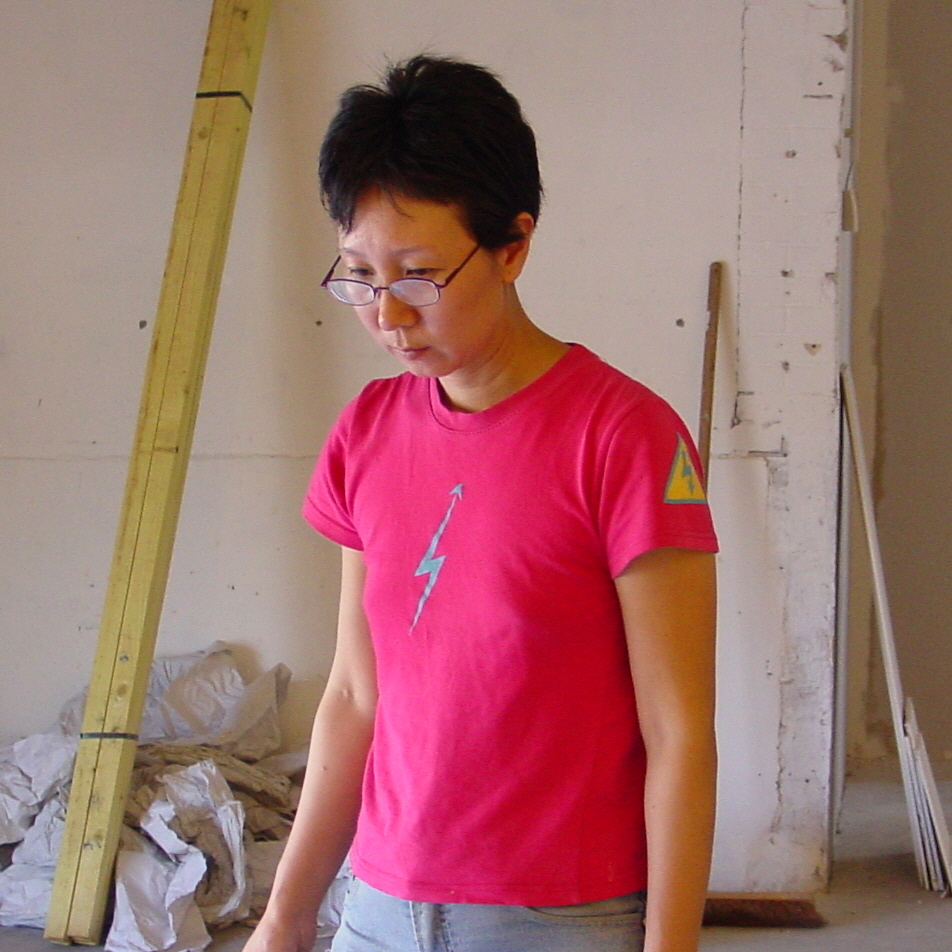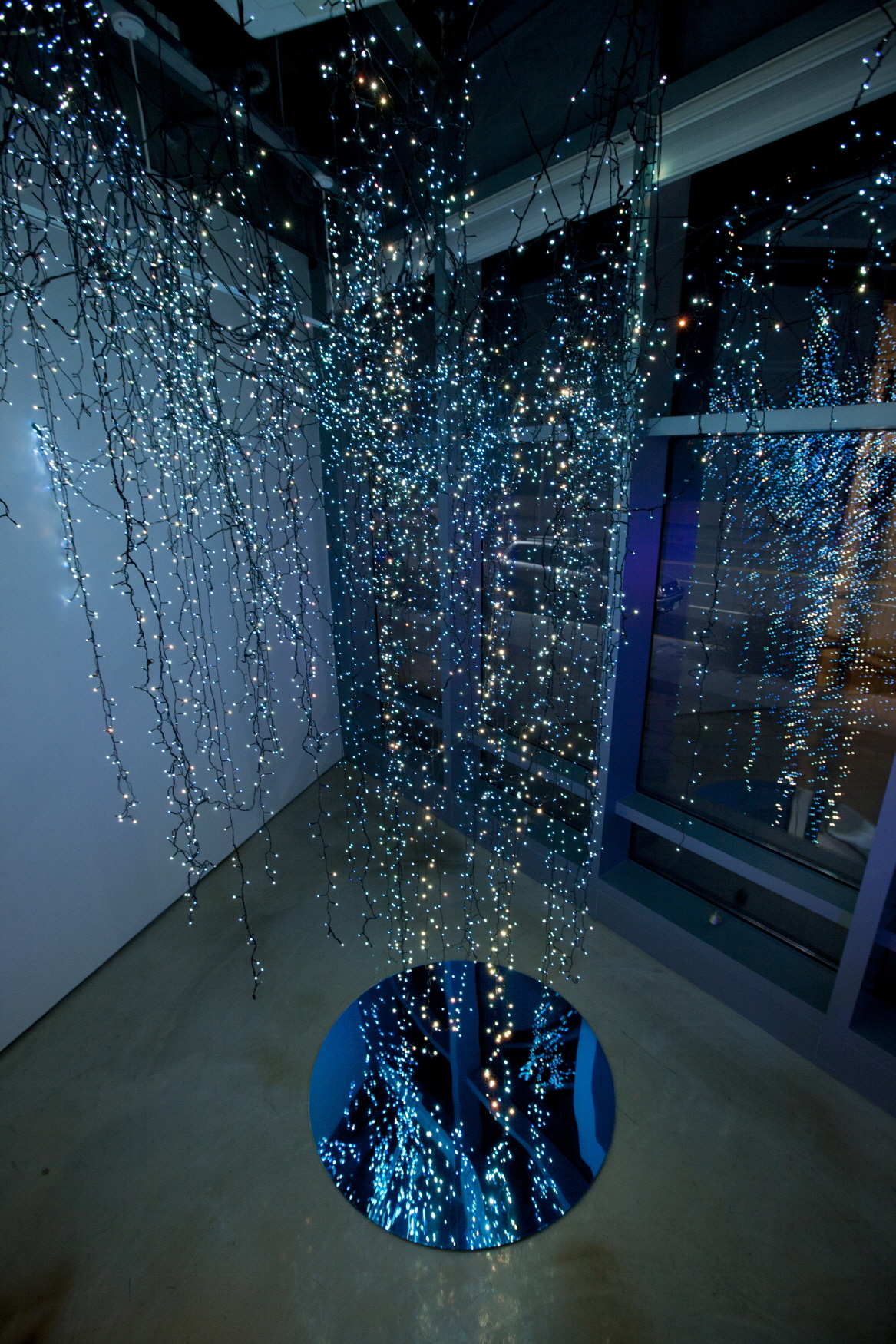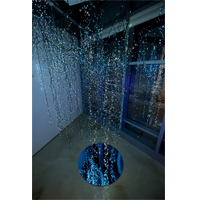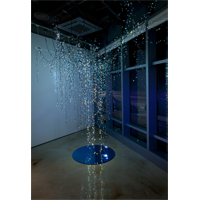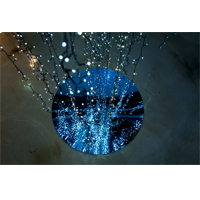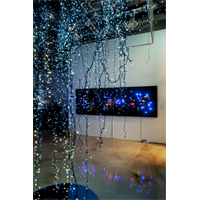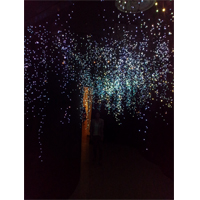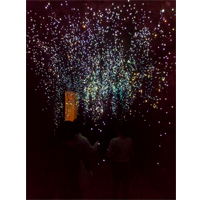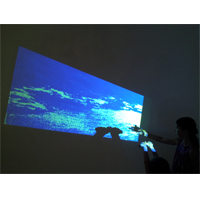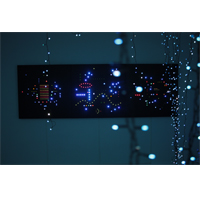Title of video “Dream”, Author : Yun Aiyoung
I
One day, in a dream, Tchouang-tseu becomes a butterfly, and is enjoying flying between the flowers waving his flags. He’s too happy to notice that he’s Tchouang-tseu, his true identity. When he wakes up, he realizes that he’s just Tchouang-tseu, not a butterfly. Tchouang-tseu starts to be lost in meditation. A while ago, when he became a butterfly, he didn’t know that he was Tchouang-tseu. After waking up, he realizes he is Tchouang-tseu. After he awakes from the dream, is he really Tchouang-tseu? Or is a butterfly dreaming about becoming Tchouang-tseu? Tchouang-tseu asks himself: “Am I really me at this moment? Or is a butterfly turned into me?”
It’s a story about a butterfly’s dream of famous Tchouang-tseu.
Thousands of worshops
The author, Yun Aiyoung has countless ateliers and the number will get bigger and bigger.
Electronic store atelier / First of all, we would like to introduce her most used atelier called herself the ‘Electronic store’ atelier. In 15th borough, there is a big apartment on a big garden where we can see lots of cafe as well; front of this apartment, 4 ateliers, affliated to the ministry of culture, are placed side by side. The first one belongs to a Roumanian artist, the second to a French sculptor, the third to the artist Yun herself, and the fourth to a Tunisia-born French artist who often works in Dublin. Even though the four artists are from different countries and have different job methods, they are on initimate terms talking about Art and their lives. Among them, the artist Yun is the youngest and is the latest person to move in to the atelier (since 2002). According to the neighbor, before Yun came to this atelier, it belonged to an old painter, who was a friend of Picasso.
Inside Yun’s atelier, on 3 sides, from top to bottom there are piles of boxes without free spaces. Inside the boxes, the exhibited works are put in. “The works breathe inside the box. Sometimes, I open these boxes to let the works have some fresh air and I repair where it should be repaired”, says the artist Yun. After an exhibit, about 6 or 7 large boxes are used and lots of wooden boxes are stored in a ‘cave(underground cell).’ In addition, some are placed in a warehouse of art galleries. Furthermore, in free spaces in my house, some objects, which were parts of works, are hidden like doing hide-and-seek. “What I want for my entire life and my living is to be live with these wooden boxes.” We have noticed when the artist Yun says that “one of the important roles of a video artist is to take care of the works and make them breathe in wooden boxes,” it isn’t that easy when we see boxes in the atelier. I understand why the artist said “I only do an electronic store” when a reporter asked her to visit the atelier. In this place, although electrical work, computer work are done and even she tests tools or installs detailed things, the real work is done in exhibition center. All 3 sides of wall are covered with boxes but mysteriously, on the half of a wall, there is a blank which proves its existence; even this part is not a wall, but a screen. “I shoot the video-project on this.” Her explanation gratified my curiosity about a black curtain draped over both sides of a big window.
Atelier-cafe / The artist Yun knows open close time of every cafes nearby. When a cafe opens, whether its morning or evening, she goes and looks at the view and people passing by for hours. “In cafes, many people have conversation, laugh, make faces and sometimes are sad and get angry. They’re raving over something but people like me sitting beside them or front of them are strangers; which make me a person out of their interests. At that time, it’s like I’m in a dream because commonly in a dream, we cannot see ourselves but we look at people doing something. In addition, on the terrace, when I see passerbies who are not conscious of my existence, I feel like falling asleep. After all, for me, cafe is another reality in a dream.”
Thus, cafe is a place where the artist Yun can experience constantly the butterfly’s dream of Tchouang-tseu. She makes plot, writes down stories in cafe which is a ‘reality in a dream’ or a ‘dream in a reality’. If the idea comes out well, she stays longer in the cafe. In general, most people work in their atelier when they are busy; on the contrary, the artist Yun spends more time in cafe. However, she’s not a regular customer to any cafes. If an employee or the owner recognizes her, from then on, Tchouang-tseu will be Tchouang-tseu, and will not be a butterfly anymore.
Atelier ? an exhibition center / For the artist Yun, the exhibition center itself is her atelier. She obtains idea and has inspiration from atelier-cafe, does the detailed experiment and editing in electronic store atelier, and finally, her works are created in the exhibition center where her works will be displayed. There are works that can be done in a short period of time, others for months. Therefore, depending on scale, art museums or galleries is the artist Yun’s atelier before varnishing.
Among these ateliers, the most important atelier for her is a ‘life’ atelier; because Yun herself, family, friends, even passerbies, meeting with a tree, past, present and future, every moment of her entire life is the most important theme and material for her works.
Paris, eternal flower blooming from deep-rooted tree
The artist Yun explains to the question: “Is United States a more attractive country for an artist?”:
“You can build new things on an empty wild plain. However, in Europe, especially in Paris, a city full of cultural heritages, building new things is possible only after a long and careful consideration. It’s because we cannot destroy these precious heritages due to new things. In addition, even if we can build new things, we have to find a way to match with existing cultural assets. Therefore, the new ones won’t be able to be noticed easily. At the time of my visit in France, it is true that not much of people practiced video art and the machinery got behind. As I mentioned just a moment ago, in a place where there is no equipment at all, you can accommodate new ones right away, but I figured out that it needs time to introduce to new unfamiliar equipments to a place where old familiar machines are already in use. Paris has few things that are new than New York; but above all that, the reason that I chose to come in France is because it’s deep-seated. I was attracted by United States, but I chose Europe where the sense is deep-seated. Also, I thought that a flower bloomed from a deep-rooted tree can be an eternal flower.”
It was never an easy thing to graft herself onto a deep-rooted tree. In the life of Paris, great and small joy and sorrow were stacked up, but the artist Yun never hesitated knocking on new doors. She realized soon enough that if she does her best at every moment given, in the end, the door will be opened and that’s why “being devoted to myself and making effort during work, and even during dish-washing make my every moment happy” she said.
“I do my best when I play and when I work; I try to do my best for everything. As an Indian philosopher of mysticism Kabir said ‘don’t be dancers, be a dance itself’, I want to run into life and be part of it. When I play with children, rather than making an effort to adapt to them, I prefer become a child because it’s happier.” She even wants to get asleep quickly with joy. The reason is that when she sleeps, an unexpected world awaits her. The artist Yun knocks on new and unknown doors endlessly and is always pleasantly surprised finding a new world behind that door. Her ‘work is a discovery rather than a creation.’ The perfect ‘creation ex nihilo’ is an unknown word for us, and as a traveler who seeks life’s mystery, her work is like ‘a discovery behind new door,’ she said.
Ⅱ
“We can explain the taste of a raspberry with a lot of adjectives, but we can only feel that sweet and sour taste after we try ourself. Like this example, my work is not only for looking at it; my work completes itself when spectators enter to it and breathe inside and when their imagination mix with it.”
The artist Yun invites us to her work and to her dream so that we don’t have to be a spectator any more, but a main agent of the work or the dream. During the work, the artist Yun starts with a basic overall form but doesn’t set a definite form of it. “If I predefine everything and follow it, it’s like me working in past. What I do in present is to be in overwhelming joy of creativity and discovery during work. In addition, when I work, I respect the fact that I feel like through a medium of ‘hand’, another me appears, controls and helps me along.”
Abyss
As Jean-Paul Fargier, an art critic from Art Press and Le Monde, had pointed out, Cho & Yun have collaborated together for a long time performing as a duo of a conflict and a harmony presented by “man & woman, a light and a shadow, and archaic symbols and modern signals.” Since 1999, Yun Aiyoung develops her activities independently. An endless pain and a hollowness of becoming a soloist from “playing” as a duo, are presented in “Abysse 3D (2000).”
For a new century, this work was invited to an exhibition “Paris en 3D” in Carnavalet museum in Paris. This exhibition had cutting-edge technology art history and presented work of stereo-imagery which represents images in the future.
The spectators discover one big barrel placed in an exhibition. Curious about it, the descendant of Eve, human beings looks into it with 3D glasses placed on both sides. The “Abyss” was made by 3D image. At the moment spectators look into a barrel ? with one meter of depth -, they face to an endless abyss and emptiness. The body, settled by 3D image, is separated to the background and it’s like an illusion floating around spectators: it reminds of “Dying slave” of Michel-angelo; it’s like a man wanders in a dark alley or on Seine river in Paris or a woman, sit crouched, who floats on a night sky. As Jean-Paul Fargier pointed out that “Yun could express well the “Abyss” even with a teacup and not a 200 L barrel,” she succeeded to put the abyss into an everyday life object. Through this simple 3D ordinary world, she expressed materialized the end of the abyss ? sleeping in the air -, the bottomless abyss’s pit and the state of the soul in 4D.
Secret Garden
Since early 2000, the artist Yun did mostly works that expressed trees. “I think that tree is like our souls that show human’s life. One day, I was frustrated and I was very exhausted and could not get out of this situation. That moment, I, who liked to see at the sky, stared vacantly at a tree and the sky. And suddenly, I felt like the tree was talking to me. The tree I was looking had its branch cut and even the body was cut. But from a remaining branch, there was a sprout coming out. However, we, the human beings, cannot find our meaning of life and give up everything when our branches and our body are cut.” The video installation was first shown in the foundation of Metronom in Barcelona for an invitation exhibit (2001). After that, it was presented in the National Museum of Arts in Saint-Petersbourg (2001), Russia, in the Saint-Pons Art Center, France and in Contemporary Art Center in Basse-Normandie (2005). The whole space of 500 m² exhibition center is set with only one work and many paths in a garden invite spectators to a walk of mystery to admire the work. In a garden, the innocent margherites are in bloom. These flowers grow in the wild; they are not fancy and do not try to expose. In addition, a tree full of plum blossom can be found. Between margherites or between branches, there are transparent screens and above that there are 3D video images swaying like vague memories or like traces of our own souls.
In the exhibition center where the “Secret Garden” is set, there people who seeks images like playing a treasure-hunt, those who take a walk in a garden like in a forest and the others who rest under a tree. “People enter inside the work and take a walk like they are walking in a dream. Some paths are closed, others are opened. During the walk, they find images hidden between trees and flowers, sometimes, they pass through them. But I don’t tell to anyone where the images are or which way is the dead end.” The artist says that: “When the spectators walk through garden, their imaginations and emotions become invisible dew and when everything is in harmony, the work completes itself.”
An invitation to a dream
To a question “how do you find work theme,” the artist Yun answers: “As if a dream comes to us and a theme of dream cannot be chosen, I don’t find theme. On the contrary, a theme comes to me.” “A dream cannot be touched but it’s a vivid dream. I feel like living in a different type of life in a different time. In a dream, I could be in France and at the same time in Korea; sometimes, I become a bird or a fish and I can have a ‘multi-space experience at the same time’. Also, I feel like being in my youth and in present at the same time, so a ‘multi-time experience’ is possible as well. Once we wake up, the fact that we flew on many spaces is forgotten; that is our most important existence and truth. For me, a dream life is my double life.” Once, the artist Yun was fascinated by an Indian mystic Liznich and a mysticism philosopher Kabir and an invisible world was her principle interest rather than visible material in this world. She liked every unrealistic thing and if it came from the bottom of her heart, she liked more. The phrase 'he fish underwater says she’s thirsty’ (Kabir, “A poem going to Heaven”) is like ‘loneliness in a crowd.’ In a world where we see only physical things, immaterial things are disregarded. Inspite the fact that the number of people are increasing, they feel lonelier and they are thirsty for love and interest.
‘Oblivion of existence’: as a modern philosopher Martin Heidegger said, the artist Yun wants to awaken another type of ‘oblivion’ to us. Through effort and admiration for existence, a human being, the unique being separated from animals and machines, progressively forgets about his existence. By forgetting dream and mystery and objectification of himself, he faces ‘God’s death’ (Nietzsche) and ‘human’s early death’ (Michel Foucault). From the Enlightenment and the Industrial Revolution to modern civilization, our world, which can be expressed by ‘ready made’, sank by spontaneity (‘hic et nunc’) and the present state. Therefore, our world forgot mystery ? ‘someday or other place’-, transcendence and infinity. The artist Yun doesn’t accept a result-based thought like asking to an apple tree seedling to bear apples immediately, or a world of ‘hic et nunc’ which is to wait teleologically for the tree bearing apples. On the contrary, she admires and amazes looking at the delicate beauty of the apple tree seedling and every moment, she also observes the apple tree growing and overcoming the hot sun and the snowstorm.
It doesn’t mean that the artist Yun denies modern civilization and insists on reactionism. On the contrary, she invites us to an ‘unfamiliar’ world of mystery by using ‘familiar’ cutting-edge technology. She is not trying to force a dual-choice by distinguishing superiority between ‘civilization’ and ‘mystery’. She is making effort continuously for ‘a mystery by civilization’s language’ and ‘visualizing dream through cutting-edge technology.’ That is why the critic, Jean-Paul Fargier says: “By working on most modernistic things, Yun Aiyoung’s thought is in a phase beyond technology and not in a phase where the humane things are disappeared, captured by technology.”
Sim Eun-rok/ 2008.03
Sim Eun-rok / Art Critic
